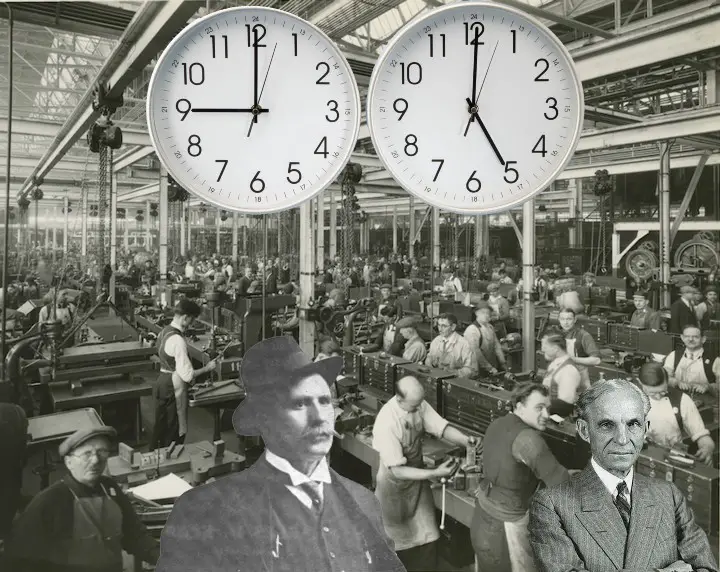 veryone complains about the traditional 8-hour workday which has become a classic staple for most job roles. Taking into consideration that most people work during the weekdays (Monday to Friday), this concludes them working a total of 40 hours a week, 160 hours a month, and around 1900 hours per year.
veryone complains about the traditional 8-hour workday which has become a classic staple for most job roles. Taking into consideration that most people work during the weekdays (Monday to Friday), this concludes them working a total of 40 hours a week, 160 hours a month, and around 1900 hours per year.
If we compare these numbers to the standards from 100 years ago you would be thankful for the 9 to 5 scheme. During the late 19th century workers were demanded to even work 18 hours per day, 6 days a week. This was very much dependent on different industries and types of employment contracts, but very few people would end up working only 8 hours a day. Even the owners of companies would put in more time.
In most cases, employees wanted as many work hours as humanly possible or even impossible due to the low hourly pay during those times. The minimum wage was only introduced in 1938 by president Franklin D. Roosevelt, so anyone before that had to work their socks off to afford the bare minimum.
Don’t get the idea that someone actually cared about people having their mental or physical health being affected by crazy working hours because they didn’t. During the 19th century, more deaths would occur in factories due to exhaustion rather than accidents. Worker’s rights were only being established in the late 19th /early 20th century.
Who influenced the 9 to 5?
There are many things that actually influenced the 8-hour working module, but one of them is really hysterical. This module is most used by America, yet it had been first thought of by a socialist. Robert Owen was one of the founders of socialism and an influential British politician.
Owen invented a module that focused on separating the 24 hours of a day as efficiently as possible whilst prioritizing the health of the worker:
- 8 hours of work
- 8 hours of recreation
- 8 hours of sleep

This model in my opinion is the best showcase of a healthy lifestyle for every employee and once again it shows the potential of socialism. To quote a famous socialist “Life is to be lived” that is why there was a focus of only having 8 hours designated for work. Recreation would fall under things such as eating, cleaning, cooking, shopping, and other daily activities. 8 hours of sleep is the perfect amount and even if it may seem too much for today’s workaholic lifestyle, for the 1800s it was perfect.
Owen presented this model to the British government in 1817, but the model was refused. It was only in 1847 that he managed to lower the working day to 10 hours for women and children, whilst there were no regulations for men. Politicians hand in hand with entrepreneurs wanted more power in the hands of employers which meant diminishing any worker’s rights.

In 1884 a member of the Federal Social Democratic party named Tom Mann brought back to discussion the 8-hour model. Mann had a lot of influence as a politician and also the support of trade unions, especially for factory workers. He managed to push Owen’s work towards actually having the British Congress listen to the sort of benefits this model would bring to employees. He even tried to sell the work model as it would bring efficiency to businesses, but those leaders were only interested in profits and that is why they once again declined the model.
It would take someone a lot more powerful and influential to actually make a change for workers. The example I am about to present next really shows that this world can only be controlled by those with a lot of money.
Making a change
The most important step for worker’s rights was taken by none other than Henry Ford. In 1905 Ford implemented the 8 hour model within all of its factories and even doubled the average salary to show that he cares for his workers. This decision had actually influenced the growth and productivity of the company whilst critics who didn’t want to give workers right said it would ruin his empire.

Despite all this, Ford showed publicly that in two years after implementing this new work model, his profits had doubled. This created an uprise for all other factories as workers demanded to have the same working hours and pay as those working for Ford. Here is when Trade Unions became really powerful and showed people that not going to work for a couple of days can bring a company to its knees, making officials adapt to the demands of workers.
Due to the fear of workers going on strike, companies have made an agreement with Governmental bodies to change the law in America. Through the Fair Labor Standards Act 1938, the American government changed the maximum working hours to 44 hours per week. This also lead to the creation of overtime pay, anything after 40 hours had to be paid double.
Over the years people have seen that this model ( in long term) is much more efficient as workers are more productive. With the evolution of the workplace, work from home jobs offer greater flexibility and a healthier work-life balance, deviating from the rigid traditional work schedules. Some companies are looking at implementing a 6-hour model, but this would not be very convenient for workers that work on an hourly basis.
Avid Writer with invaluable knowledge of Humanity!
Upcoming historian with over 30 million views online.
“You make your own life.”





